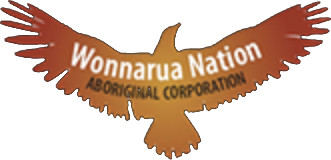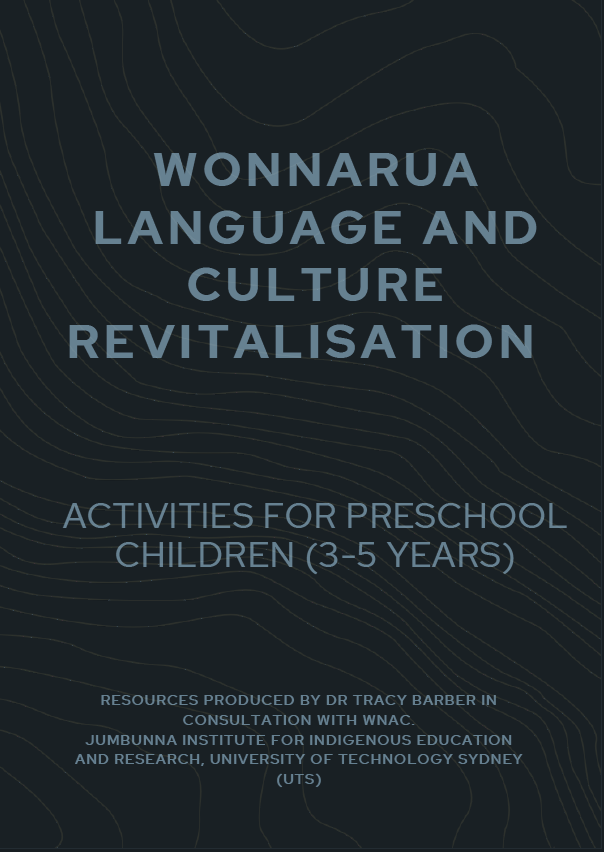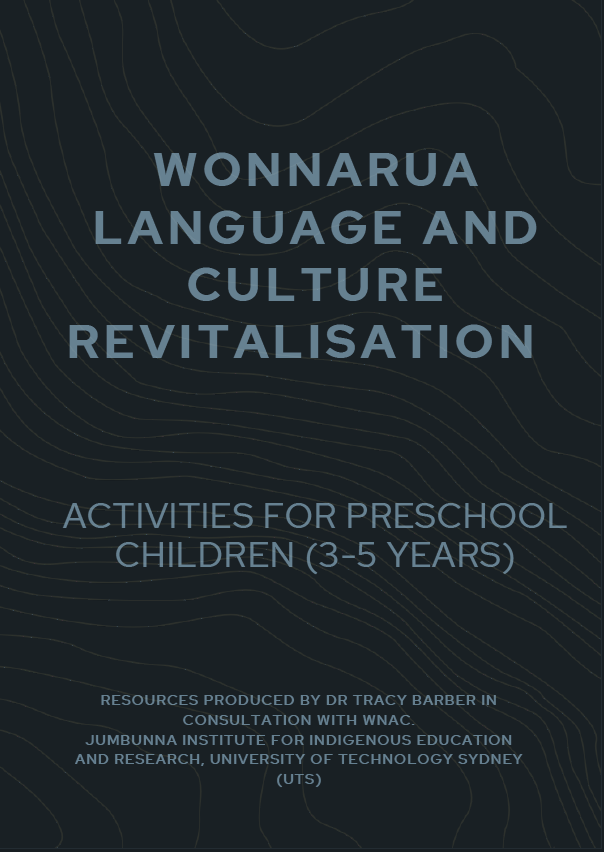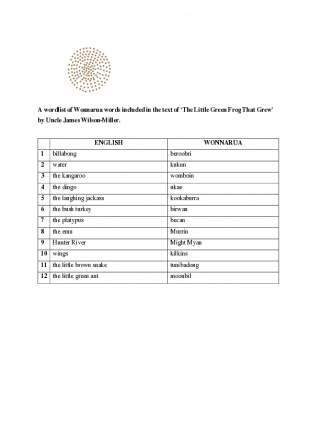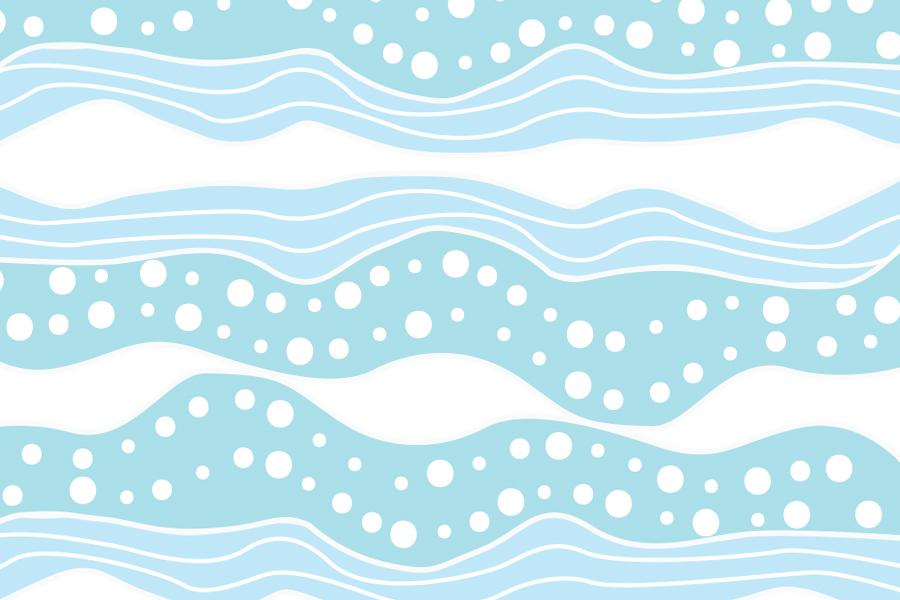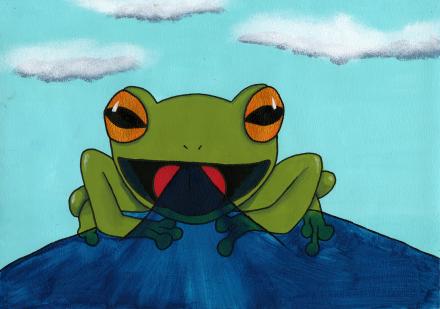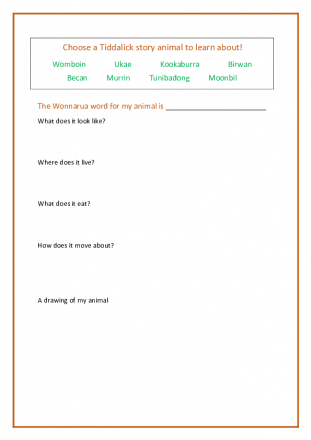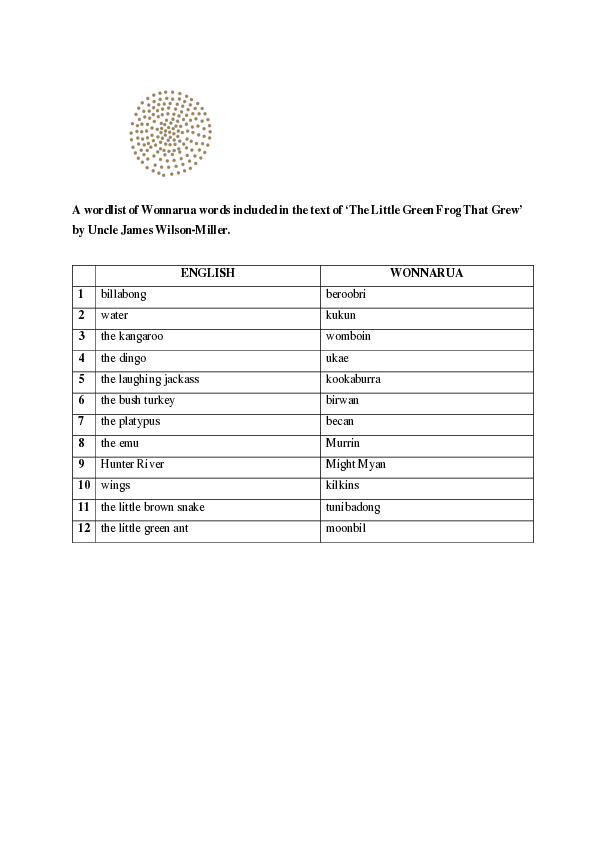Activities for preschool children (3-5 years)
Wonnarua language and culture revitalisation
Activities for preschool children (3-5 years)
The Wonnarua Tiddalick story is a great resource to use with preschool aged children. This section provides some suggestions for storytelling, physical play and art activities based on the story. They could be used in a preschool/childcare setting (please see links to the Early Years Learning Framework below) or adapted for home or community.
Mukurtu resources used in the unit
- The Tiddalick story by James Wilson Miller
- The Tiddalick word list
- Photo image of the Tiddalick rock formation site.
Other resources required
- Images of the animals in the Tiddalick story.
- Images of a billabong setting.
- Obstacle course with equipment set up to prompt a wide range of movements (jumping, balancing, hopping).
- Materials for creating collages inspired by the Tiddalick story – e.g. bark, leaves, sand, paper of different textures, glue
- Painting materials - paints, paint brushes, easels.
Activities
1. Group story telling
Suggested time: 30 minutes
Objectives
- Children develop awareness of a traditional Wonnarua story.
- Children have a greater awareness of the environmental context of the story, including animals, plants and water sources.
- Children’s awareness of sharing, caring and respect for others is deepened.
- Children are introduced to a range of Wonnarua words.
Resources and setting
- The Tiddalick story by James Wilson Miller.
- Images of the animals in the Tiddalick story.
- Photo image of the Tiddalick rock formation site.
- A natural outdoor setting is preferred, with capacity to sit in a circle on the ground. If this is not possible the activity can be conducted indoors.
Process
- Gather children together in a circle, if possible on the ground in a natural outdoor setting but if not on the floor in an indoor space.
- Explain to the group that they are going to hear an old story from the Wonnarua culture, and that the Wonnarua are Aboriginal people who have lived in the area for thousands of years. Acknowledge if there are children with Wonnarua heritage in the group.
- Explain that the story has some Wonnarua words in it and ask the children to listen carefully for the words.
- Read the story to the group and afterwards talk with the children about it. Possible guiding questions could include:
- Why was the little frog Tiddalick upset?
- Why do you think the other animals didn’t let him get to the water?
- What else could Tiddalick have done besides drinking all the water?
- How did the animals try to persuade Tiddalick to give back the water?
- What else might the animals have done?
- Where were they – have you been to a billabong?
- Talk about the Wonnarua words in the story and choose some to repeat with the children, showing an image of the animal while repeating the word.
- Tell the group that they are now going to see a picture of the place where Tiddalick is said to have been turned into stone. Show the photo and talk about it together noting details about the rock formation, surrounding area.
Assessment/Evaluation
- Over the next few days the educator could review children’s recall of the story and Wonnarua words, by looking at the animal images and noting students’ recall and level of engagement.
2. Physical imaginative play based on the story
Suggested time: 60 minutes
Objectives
- Children’s connection and involvement with the Tiddalick story are deepened through a creative, physical play experience.
- Children’s imagination and exploratory thinking about the Tiddalick story is stimulated through play.
- Children’s recall of Wonnarua words is strengthened through associated physical activity and play.
Resources and setting
- Images of the animals in the Tiddalick story.
- Outdoor setting.
- Obstacle course with equipment set up to prompt a wide range of movements (jumping, balancing, hopping).
- If possible set up space with appropriate props: this could include blue material/other resource to represent the billabong, toy animals similar to those in the story arranged around the setting.
Process
- Undertake this activity soon after reading the Tiddalick story.
- Explain that ‘now we’re all going to pretend to be the animals from the Tiddalick story’. If indoors, move to an open outdoor setting with plenty of space for physical movement.
- Ask one child to think of an action for one of the animals. For example ‘show us how the snake moves’. Child shows the group and everyone copies the action.
- Give the Wonnarua word for snake again and show the image (or give to the child to hold/show to the group), asking the children to repeat. Do the same for each of the animals.
- Explain that now all the animals are going to the billabong to drink and to get there you have to go through the bush (the obstacle course). Demonstrate the use of the course – e.g. jump like a kangaroo, slither like a snake through grass, swim like the platypus in the river, fly like the kookaburra).
- Children take turns using the obstacle course to get to the billabong to drink.
- Conclude with time for free play with props in the outdoor setting.
Assessment/Evaluation
- Educator observes children’s level of engagement with the activity, during the educator-led section and during free play.
- Educator follows up with reference to Wonnarua words and notes children’s capacity for recall.
3. Art work based on story
Suggested time: 45 minutes
Objectives
- Children’s imaginative engagement with the Tiddalick story is enhanced through a visual art experience.
- Children’s understanding of the billabong environment is deepened through engaging in producing a visual representation using a range of natural materials.
- Children’s recall of Wonnarua words is strengthened through art activity.
Resources and setting
- The Tiddalick word list.
- Images of the animals in the Tiddalick story.
- Images of a billabong setting.
- A collection of natural and processed materials to be used in creating a collage inspired by the Tiddalick story – e.g. bark, leaves, sand, paper of different textures, glue
- Paints, paint brushes.
Process
- Set up room for two art activities – collage making and painting.
- Introduce activity by asking the children to think about the Tiddalick story. Pointing to the different images ask the children if they know the Wonnarua word for the animal. Prompt students with word. Also show images of the billabong setting and note its features with the children and use Wonnarua words (beroobri – billabong and kukun – water).
- Divide the children across the two activities. If time, children could swap activities to produce another image.
- Students use materials to create art works based on the story.
- Create a display in the room using the students’ art work, the images of animals and the billabong and the photo of the Tiddalick rock formation.
- Include words from the Tiddalick word list underneath the images created by the children of animals and the environment.
Assessment/Evaluation
- Educator observes children’s level of engagement with the activity.
- Educator notes children’s capacity to recall Wonnarua words.
Links to Belonging, Being and Becoming: The Early Years Learning Framework for Australia
Outcome 1: Children have a strong sense of identity
Children feel safe, secure and supported
Children learn to interact in relation to others with care, empathy and respect
Outcome 2: Children are connected with and contribute to their world
Children develop a sense of belonging to groups and communities and an understanding of the reciprocal rights and responsibilities necessary for active community participation
Children respond to diversity with respect
Outcome 4: Children are confident and involved learners
Children develop dispositions for learning such as curiosity, cooperation, confidence, creativity, commitment, enthusiasm, persistence, imagination and reflexivity
Outcome 5: Children are effective communicators
Children interact verbally and non-verbally with others for a range of purposes
Children express ideas and make meaning using a range of media
The wider learning context
1. Integrate Wonnarua language and culture teaching into other parts of the curriculum by including relevant Wonnarua words and short everyday phrases. For example, develop word lists for other books, other lesson content and display around the classroom.
2. Integrate general awareness and understanding of Wonnarua history, language and culture when introducing words and phrases.
